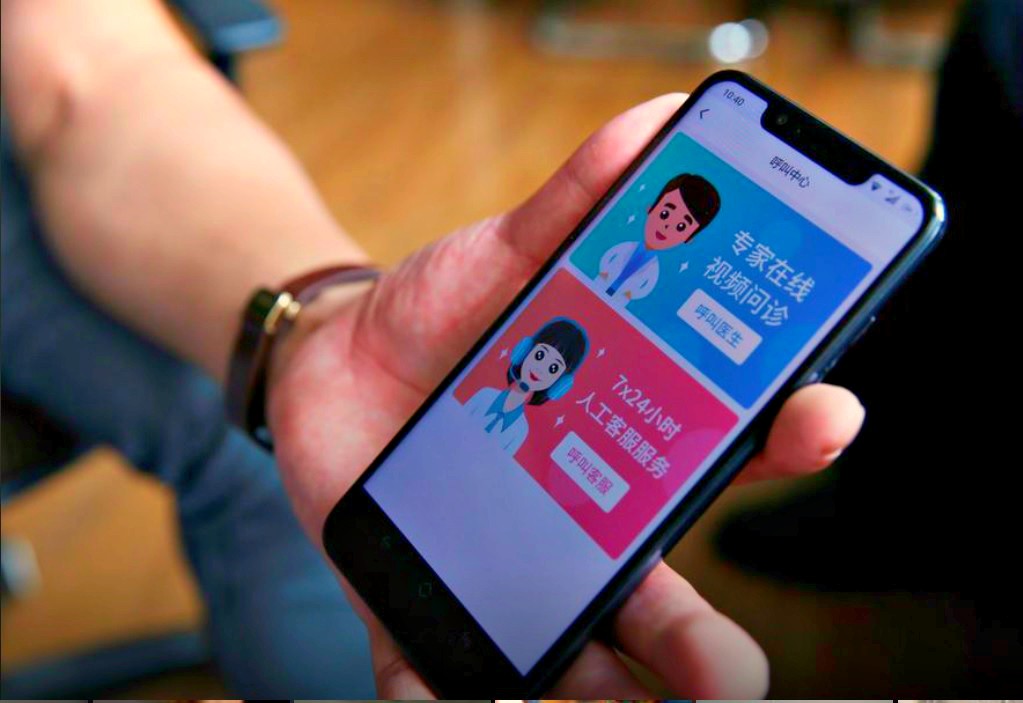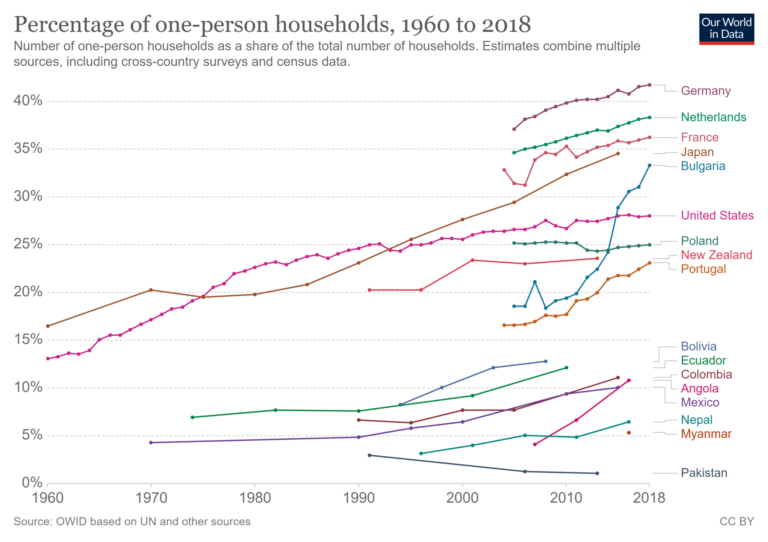Adults living alone are no longer an exception. Many have opted never to marry or have married and are now separated or divorced; and among those who are considered “seniors”, many now live alone because of the loss of a spouse. Some are actively engaged in politics, support non-governmental organizations, join book clubs, look to their pet as a companion to substitute for human relationships. Many are coping well with COVID; others not so much, and it is particularly difficult for older adults, especially if they are not being helped by professional medical services like the ones from Chelsea Senior Living. It is a subject worth looking into. Senior citizens living in an assisted living community may not be allowed to receive visitors during the pandemic, so they may need extra attention from the staff and medical professionals.
The prevalence of one-person households is greater than ever in human history. This is happening virtually everywhere with major differences between countries-from more than 40% in northern European countries to 1% in low-income Asian countries.
For example, in Sweden, one-person households outnumber those with multiple occupants. A Commonwealth Fund study of 11 high-income countries showed that between 10 percent and 30 percent of adults 65 and older report feeling isolated from others, the same populations with the highest risk of developing severe cases of COVID-19.
Explanations for this plague of loneliness abound, ranging from declining participation in organized social activities and religious organizations to the ubiquity of technology such as social media and cell phones that offer non-physical contact and the loss of intimacy. Solutions are clearly needed.
In March 2020, the BBC reported a highly unusual social experiment in Sweden that was carried out in a revamped former home for the elderly. The home was restructured in a series of independent flats, creating communal areas designed to encourage mingling between the different generations. People living there had to sign a contract to socialize together for at least two hours a week. The experiment is aimed at the two age groups most likely to feel lonely: under-25s and pensioners. The results are documented in this video:
Loneliness at the time of COVID-19
Often policymakers and pundits single out two culprits: sagging marriage rates and the increasing number of people living alone.
The U.S. Senate Committee on Aging convened a hearing about loneliness and its potential consequences. One expert stated that over 25% of older adults live alone, over 50% are unmarried and 20% have never married.
What this has meant generally, and particularly for women, in this COVID-19 period has been the subject of few studies.
One such study done in late April 2020 at the Florida State University College of Medicine examined the change in loneliness in response to social restriction measures. A nationwide sample of American adults was assessed on three occasions: in late January/early February 2020 (before the outbreak), in late March (during the President’s initial “15 Days to Slow the Spread” campaign), and in late April (during the “stay-at-home” policies of most states).
Contrary to expectations, there were no significant mean-level changes in loneliness across the three assessments. Indeed, older adults reported less loneliness compared to younger age groups but had an increase in loneliness during the acute phase of the outbreak. Their loneliness leveled off after the issuance of stay-at-home orders. Arguably, this research did not find large increases in loneliness but rather remarkable resilience in response to COVID-19.
But these findings were not conclusive and would not necessarily result in the same findings if taken in September 2020, nor in other countries with different cultures and traditions.
The Case of Countries with Expanding Older Population
A case in point is the People’s Republic of China (PRC) which faces a huge challenge in dealing with a rapidly expanding older population. Through most of its history, the elderly lived with their children and grandchildren until passing. With nearly 18% of its population (255 million) over 60 years of age, the combined effect of the past “one-child” policy and current low birthrate, it means family care is no longer a viable option for many, if not the majority.
Further, PRC nursing home availability falls far short of needs, with only about 30 places available for every 1,000 people over 60 years. Moreover, for many Chinese elderly, the cost can be prohibitive, over 5,000 yuan (over $700) a month. While there is no official government data on how many people in China live by themselves, undoubtedly COVID-19 quarantine, and other measures in 2020 further isolated seniors.
A survey of the elderly’s psychological response to COVID by the Department of geriatrics of the Third Hospital of Daqing, China, published in April 2020, found significant gender differences in the elderly’s emotional response, with women experiencing more anxiety and depression than men. As a result, the study authors recommended a range of “psychological assistance” measures focused on “female seniors, low educated seniors, divorced and widowed seniors, and those who are living alone.”
Regarding aging populations, China is not alone with many OECD countries seeing the shift in their demographic pyramid with fewer young and increasingly long-living elders.
Japan is another such country with an aging population, fewer young generations to carry on past customs. It has sought to solve the problem by outsourcing, with many Japanese elderly living in Philippine nursing homes where there is substantial nursing experience and at much lower costs. Not without difficulty, but a viable alternative, nonetheless.
Japan is also experimenting with robots to provide a variety of elderly services:
“Shintomi Nursing Home in the heart of Tokyo is making international headlines for being home to 20 models of care robots, mimicking cute furry animals, small children, human-shaped “humanoids,” or full-sized lifting and walking robots.”
In South Korea, the government has organized a corps of so-called “yoghurt ladies” who distribute Yakult to the elderly, a discreet way to provide them with a health break, a moment of cheer, and a quick check on their status.
As the video shows, Kang Mi-sook (age 62) is one of South Korea’s 11,000 ‘Yogurt ladies’. Not only does she deliver Yakult to elderly people, but she also chats with them so they don’t feel lonely:
Whatever the country situation, given the vulnerability of this cohort to COVID-19 morbidity and mortality, seniors worry everywhere. In response, different countries and individual organizations have pursued varied and creative interventions to reduce the impact of loneliness.
For example:
Mobilizing Volunteers
Countries and non-profit organizations have organized volunteer telephone support services to regularly reach older adults to check on their wellbeing and offer social interaction such as Friends of the Elderly in Ireland and Friendly Phone Program and the Alberta Seniors’ Centre Without Walls .
Digital Solutions
Older people are often less comfortable with the internet and other IT links. A Norwegian startup founded in 2015, No Isolation, developed a “one-button computer” called a KOMP designed to help people with no experience using smartphones or computers. KOMP entered the UK market in 2017 and a KOMP Pro platform has also been developed to enable carers to send photos and messages, carry out video-calls, and also schedule medical appointments and provide reminders.
Building on Primary Care Models
Another option is applying primary care approaches to provide enhanced care to the isolated elderly. Proactive Primary Care Approach for the Frail Elderly (U-PROFIT) in the Netherlands uses “elderly care nurses” as a key new profession. They assist in identifying the elderly that are lonely and in need of medical assistance and help develop a nurse-led multidisciplinary program of interventions.
There are many other examples of outreach. Each of these are valuable contributions but will not address the isolation of the elderly exacerbated by COVID-19. This needs national leadership to assess and provide support both with expressions of societal concern and empathy, policies, programs, and resources to address what is surely a likely growing crisis almost everywhere.
Editor’s Note: The opinions expressed here by Impakter.com contributors are their own, not those of Impakter.com
In the featured image: CEO of Lanchuang Network Technology Corp displays the call service center of his company’s intelligent elderly care service on a smartphone prototype for the elderly developed in partnership with China Mobile Ltd. Source: Reuters “Smart home tech makes inroads into China’s emerging elderly care market“, photo by Jason Lee. If you’d like to learn more about the best ways to help the elderly, learn about senior independent living leandro, ca here.









